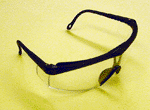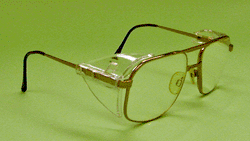Eye Splash Protection

 Safety glasses are necessary as the minimum protection when a potential exists for liquid splashes to your
eyes. Safety glasses are a minimal protection and should only be used when small volumes of
liquids are involved. The determaination of whether to use safety glasses, with or without
side shields, or splash goggles should be addressed in the hazard assessment.
This occurs most commonly in much chemical work. The
requirement for splash protection by safety glasses may be obviated by the use of
eye/face protection by means of a more protective item, such as splash goggles
.
Safety glasses are necessary as the minimum protection when a potential exists for liquid splashes to your
eyes. Safety glasses are a minimal protection and should only be used when small volumes of
liquids are involved. The determaination of whether to use safety glasses, with or without
side shields, or splash goggles should be addressed in the hazard assessment.
This occurs most commonly in much chemical work. The
requirement for splash protection by safety glasses may be obviated by the use of
eye/face protection by means of a more protective item, such as splash goggles
.
 Safety glasses (with side shields if stipulated by the hazard
assessment pertaining to the work) which conform to ANSI Z87.1
specifications. (They will be stamped with Z87.1 if they conform.
Side shields are necessary with safety
glasses if there is a chance of a splash coming from the side. Safety glasses (with side shields if stipulated by the hazard
assessment pertaining to the work) which conform to ANSI Z87.1
specifications. (They will be stamped with Z87.1 if they conform.
Side shields are necessary with safety
glasses if there is a chance of a splash coming from the side.
 The
proper donning and doffing (putting on and taking off) of eye protection is largely
intuitive for most people, but the following points are emphasized. Safety glasses
do not usually fit well over your regular prescription eyeglasses, if you wear eyeglasses,
and therefore the level of protection afforded is decreased. Either splash goggles designed
to be worn over glasses or prescription safety glasses are the
correct alternatives for those who wear eyeglasses. Before wearing
safety glasses, inspect them for weaknesses, cracks, scratches, etc. and
replace them if they are flawed, will not stay in place, or impair your vision.
Safety glasses have been properly put on when they are situated comfortably on
the face in such a manner that they cover both eyes, will not slip down, and allow you to
see your work. Side shields are necessary with safety glasses if there is a chance
of a splash coming from the side. Removing the goggles or glasses requires no special
precautions unless they have been splashed or in some manner contaminated with a harmful
liquid or solid that could get into your eyes. In this case you may have to make a
very rapid decision concerning the merits of removing the glasses BEFORE or AFTER you get your face into the eyewash or emergency shower.
Always know where the eyewash and shower are located, and how to get there with
your eyes closed! (And keep the path from your work to that location completely
clear of trip/slip hazards.) The
proper donning and doffing (putting on and taking off) of eye protection is largely
intuitive for most people, but the following points are emphasized. Safety glasses
do not usually fit well over your regular prescription eyeglasses, if you wear eyeglasses,
and therefore the level of protection afforded is decreased. Either splash goggles designed
to be worn over glasses or prescription safety glasses are the
correct alternatives for those who wear eyeglasses. Before wearing
safety glasses, inspect them for weaknesses, cracks, scratches, etc. and
replace them if they are flawed, will not stay in place, or impair your vision.
Safety glasses have been properly put on when they are situated comfortably on
the face in such a manner that they cover both eyes, will not slip down, and allow you to
see your work. Side shields are necessary with safety glasses if there is a chance
of a splash coming from the side. Removing the goggles or glasses requires no special
precautions unless they have been splashed or in some manner contaminated with a harmful
liquid or solid that could get into your eyes. In this case you may have to make a
very rapid decision concerning the merits of removing the glasses BEFORE or AFTER you get your face into the eyewash or emergency shower.
Always know where the eyewash and shower are located, and how to get there with
your eyes closed! (And keep the path from your work to that location completely
clear of trip/slip hazards.)
 Protective eyewear is limited mostly by whether you remember to keep it on your eyes. Three
out of five work related eye injuries result from workers not wearing any protective eyewear.
Safety glasses will not protect adequately against violent explosions
of apparatus or chemical reaction set-ups; if this is a possibility there should be a
blast shield between you and the apparatus or set-up. Protective eyewear, especially
plastic, can become scratched and scuffed to the point where it interferes with vision --
dispose of equipment when this is the case.
Protective eyewear is limited mostly by whether you remember to keep it on your eyes. Three
out of five work related eye injuries result from workers not wearing any protective eyewear.
Safety glasses will not protect adequately against violent explosions
of apparatus or chemical reaction set-ups; if this is a possibility there should be a
blast shield between you and the apparatus or set-up. Protective eyewear, especially
plastic, can become scratched and scuffed to the point where it interferes with vision --
dispose of equipment when this is the case.
 Safety
glasses should be kept clean with mild soap and water, and stored in a dry, temperate
atmosphere out of harm's way. Avoid scratching the lens on your
safety glasses by not placing them on a table with the lens facing down.
If protective eyewear items are not
contaminated with chemical, biological, or radioactive material, there are no special
disposal considerations; they are regular trash. Safety
glasses should be kept clean with mild soap and water, and stored in a dry, temperate
atmosphere out of harm's way. Avoid scratching the lens on your
safety glasses by not placing them on a table with the lens facing down.
If protective eyewear items are not
contaminated with chemical, biological, or radioactive material, there are no special
disposal considerations; they are regular trash.
|







